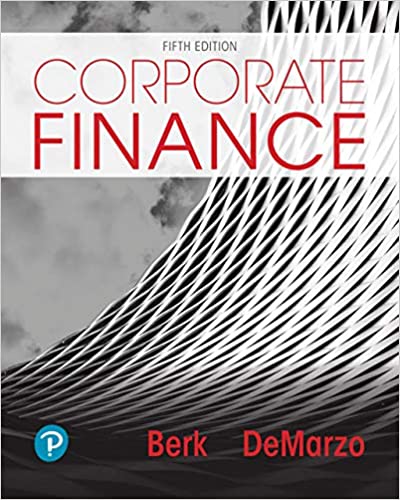This is the eBook of the printed book and may not include any media, website access codes, or print supplements that may come packaged with the bound book.
NOTE: Before purchasing, check with your instructor to ensure you select the correct ISBN. Several versions of the MyLab™and Mastering™ platforms exist for each title, and registrations are not transferable. To register for and use MyLab or Mastering, you may also need a Course ID, which your instructor will provide.
Used books, rentals, and purchases made outside of Pearson
If purchasing or renting from companies other than Pearson, the access codes for the MyLab platform may not be included, may be incorrect, or may be previously redeemed. Check with the seller before completing your purchase.
For MBA/graduate students taking a course in corporate finance.
This ISBN is for the MyLab access card. Pearson eText is included.
An emphasis on modern theory blended with practice elevates students’ financial decision making
Using the valuation framework based on the Law of One Price, top researchers Jonathan Berk and Peter DeMarzo have set the new canon for corporate finance textbooks. Corporate Finance, 5th Edition blends coverage of time-tested principles and the latest advancements with the practical perspective of the financial manager. Students have the opportunity to “practice finance to learn finance” by solving quantitative business problems like those faced by today’s professionals. With built-in resources to help students master the core concepts, students develop the tools they need to make sound financial decisions in their careers.
For a streamlined book specifically tailored to the topics covered in the first one-semester course, Corporate Finance: The Core, 5th Edition is also available by Jonathan Berk and Peter DeMarzo.
Personalize learning with MyLab Finance
By combining trusted author content with digital tools and a flexible platform, MyLab personalizes the learning experience and improves results for each student.Auto-graded Excel Projects and critical-thinking exercises help foster real-world skills.
چکیده فارسی
این کتاب الکترونیکی کتاب چاپ شده است و ممکن است شامل هیچ رسانه، کد دسترسی به وبسایت یا مکمل چاپی نباشد که ممکن است همراه با کتاب صحافی شده باشد.
توجه: قبل از خرید، با مربی خود مشورت کنید تا مطمئن شوید شبکه صحیح را انتخاب کردهاید. نسخه های متعددی از پلتفرم های MyLab™ و Mastering™ برای هر عنوان وجود دارد و ثبت نام ها قابل انتقال نیستند. برای ثبت نام و استفاده از MyLab یا Mastering، ممکن است به یک شناسه دوره، که مدرس شما ارائه خواهد کرد نیز نیاز داشته باشید.
کتابهای استفاده شده، اجارهها و خریدهای خارج از پیرسون
در صورت خرید یا اجاره از شرکتهایی غیر از پیرسون، ممکن است کدهای دسترسی برای پلتفرم MyLab گنجانده نشده باشد، ممکن است نادرست باشد، یا ممکن است قبلا بازخرید شده باشد. قبل از تکمیل خرید خود با فروشنده مشورت کنید.
برای دانشجویان MBA/فارغ التحصیل که دوره ای را در زمینه امور مالی شرکت می گذرانند.
این ISBN برای کارت دسترسی MyLab است. Pearson eText گنجانده شده است.
تأکید بر نظریه مدرن و آمیخته با عمل، تصمیم گیری مالی دانشجویان را ارتقا می دهد
با استفاده از چارچوب ارزش گذاری بر اساس قانون یک قیمت، محققین برتر جاناتان برک و پیتر دیمارزو قانون جدیدی را برای کتاب های درسی مالی شرکت ها تنظیم کرده اند. مالی شرکت، ویرایش پنجم پوشش اصول آزمایش شده زمان و آخرین پیشرفتها را با دیدگاه عملی مدیر مالی ترکیب میکند. دانشآموزان این فرصت را دارند که با حل مشکلات کمی کسبوکار مانند مشکلاتی که متخصصان امروزی با آن مواجه هستند، «برای یادگیری امور مالی، امور مالی را تمرین کنند». با منابع داخلی برای کمک به دانشآموزان برای تسلط بر مفاهیم اصلی، دانشآموزان ابزارهایی را که برای تصمیمگیری مالی صحیح در حرفهشان نیاز دارند، توسعه میدهند.
برای یک کتاب ساده که به طور خاص با موضوعات تحت پوشش در دوره یک ترم اول طراحی شده است، مالی شرکت: هسته، ویرایش پنجم همچنین توسط جاناتان برک و پیتر دیمارزو.
یادگیری را با MyLab Finance شخصی کنید
MyLab با ترکیب محتوای نویسنده قابل اعتماد با ابزارهای دیجیتال و یک پلتفرم انعطافپذیر، تجربه یادگیری را شخصی میکند و نتایج را برای هر دانشآموز بهبود میبخشد. پروژههای Excel با درجهبندی خودکار و تمرینهای تفکر انتقادی به تقویت مهارتهای دنیای واقعی کمک میکنند.
ادامه ...
بستن ...










